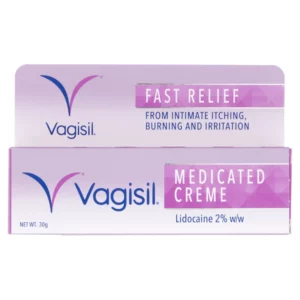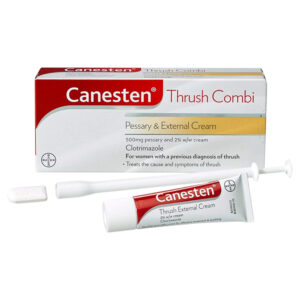Thrush
Vaginal thrush treatments are specifically formulated to combat vaginal thrush (candidiasis), a common yeast infection affecting many women. Read More…

-

Clotrimazole 1% Cream
- Relieves Fungal Skin Infections
- Active Ingredient: Clotrimazole
- Treats Fungal Nappy Rash
£2.19 – £6.99 Select options This product has multiple variants. The options may be chosen on the product page -

Fluconazole 150mg Capsule
- Relief From Symptoms Of Vaginal Thrush
- Active Ingredient: Fluconazole
- Clears Infection Within One Week
-

Canesten Dermatological Spray – 40ml
- Relieves Fungal Skin Infections
- Active Ingredient: Clotrimazole
- Treats Fungal Sweat Rash
-

Canesten 2% Thrush Cream – 20g
- Active Ingredient: Clotrimazole 2%
- Relieves Irritation From External Vaginal Thrush
- Buy With Confidence From UK Registered Pharmacy
-

Clotrimazole Vaginal Pessary 500mg – 1 Pessary
- Clotrimazole Pessary Is a Single Application Used For The Treatment Of Vaginal Thrush
- Active Ingredient: Clotrimazole
- Next Day Delivery Available
-

Canesten Thrush 150mg Oral Capsule
- Active Ingredient: Fluconazole
- Relieves Thrush Symptoms
- Buy With Confidence From UK Registered Pharmacy
-

Canesten Soft Gel 500mg Thrush Pessary
- Designed for comfort
- Easy to use and effectively clears infection
- Buy with confidence from UK registered pharmacy
-

Canesten 500mg Pessary – 1 Pessary
- Active Ingredient: Clotrimazole
- Treatment For Vaginal Thrush
- Buy with confidence from UK registered pharmacy
-

Canesten Thrush Duo – Oral Capsule & External Cream
- Active Ingredient: Fluconazole & Clotrimazole
- Relieves Thrush
- Buy With Confidence From UK Registered Pharmacy
-

Vagisil Medicated Creme 30g
- Fast Relief From Intimate Itching, Burning And Irritation
- Active Ingredient: Lidocaine
- Recommended By UK Doctors
-

Canesten Combi – Pessary & External Cream
- Active Ingredient: Clotrimazole
- 500mg Pessary & 2% w/w Cream
- Treat For Vaginal Thrush
-

Canesfresh Soothing Wash Gel – 200ml
- Provides 12 Hours Of Comfort & Freshness
- Can Be Used As A Daily Wash
- Next Day Delivery Available
-

Canestest Self-Test for Vaginal Infection
- Test For Common Vaginal Infections
- Self - Test That Is Easy To Use
- Buy With Confidence From UK Registered Pharmacy
-

Canesflor Probiotics for Vaginal Use – 10 Capsules
- Prevents Thrush & Bacterial Vaginosis
- Vaginal Capsule That Delivers Probiotics
- Buy With Confidence From UK Registered Pharmacy
-

Canesten 500mg Thrush Pessary
- Active Ingredient: Clotrimazole
- Suitable for: Adults aged 16 to 60 years old
- Buy with confidence from UK registered pharmacy
-

Canesfresh Initmate Care Daily Foaming Wash – 150ml
- Helps Maintain Natural pH Level In The Vaginal Area
- Can Be Used Daily
- Buy With Confidence From UK Registered Pharmacy
-

Canesten Combi – Soft Gel Pessary & External Cream
- Active Ingredient: Clotrimazole
- Suitable For: Adults aged 16 to 60 years old
- Relieves Thrush
-

Canesten Thrush Combi Internal & External Creams
- For women with a previous diagnosis of thrush
- Treats the cause and symptoms of thrush
- Treatment is easy to use at home
-

Canesten 10% Vaginal Cream
- Active Ingredient: Clotrimazole
- Pre-filled Applicator
- Buy With Confidence From UK Registered Pharmacy
-
About Vaginal Thrush
Vaginal thrush, medically known as candidiasis, is a prevalent yeast infection arising from an overgrowth of Candida albicans. This fungus normally lives in the bowel and in small numbers in the vagina and is usually harmless. However, various factors can lead to an increase in yeast, leading to symptoms. About three-quarters of women will experience vaginal thrush at some point in their lives. It’s not classified as a sexually transmitted infection (STI), but sexual activity can sometimes contribute to its development. Thrush isn’t limited to the vaginal area and can also present as oral thrush. While uncomfortable, thrush is treatable and does not cause long-term health issues. It can sometimes indicate an underlying condition if it occurs recurrently. Factors that can prompt an overgrowth of Candida include recent antibiotic use, hormonal changes due to the menstrual cycle or pregnancy, certain health conditions such as diabetes or iron deficiency, and the use of immunosuppressive medications. Lifestyle factors, such as tight clothing and non-breathable underwear, can also contribute.
-
Symptoms
Symptoms of vaginal thrush can vary among individuals, but common signs include:
Itchiness and soreness around the vagina and vulva
A thick, white discharge resembling cottage cheese that typically does not have an odor
Discomfort or pain during sexual intercourse
A stinging sensation when urinating
Redness or cracks in the skin of the vulva, especially if the infection is severeThese symptoms can sometimes fluctuate with your menstrual cycle, worsening just before your period and improving during it. It’s important to be aware of your body and to recognize any changes or recurrent patterns in these symptoms.
-
Diagnosis: Vaginal Thrush
Diagnosing vaginal thrush involves a medical evaluation by a healthcare professional, usually a general practitioner (GP) or a gynaecologist. The diagnosis typically includes:
Symptom Assessment: The GP will ask about your symptoms, such as itching, discharge, and discomfort. Some symptoms of thrush can be similar to those of sexually transmitted infections (STIs), so it’s important to provide accurate and detailed information.
Medical History: The doctor may inquire about your medical history, sexual activity, and any previous occurrences of thrush or similar infections to determine if thrush or an STI is more likely.
Physical Examination: A visual examination of the vaginal and vulval area may be conducted to check for signs of thrush, such as redness, swelling, or discharge.
Swab Test: If the diagnosis is unclear, the GP may take a swab of the vaginal discharge to test for the presence of Candida or other infectious agents. This is a simple and painless procedure where a small sample is collected using a cotton swab.
Urine Test: In some cases, a urine test may be recommended to check for cystitis, especially if you have symptoms like pain during urination.
Further Testing: If thrush is recurrent or if treatments are not effective, further tests may be advised to rule out underlying conditions, such as diabetes or a weakened immune system.It’s important to consult a healthcare professional for an accurate diagnosis and appropriate treatment plan.
-
Treatments
Over-the-counter (OTC) medications for thrush can be quite effective for managing symptoms and treating the infection. These medications typically include antifungal agents, which work by killing the yeast fungus responsible for the infection. Treatments come in various forms, such as oral capsules, creams, and sprays. Common active ingredients in these treatments include clotrimazole and fluconazole, which are found in products like Canesten and Diflucan. These ingredients target the growth of the fungus, providing relief from symptoms such as itching, irritation, and discharge. For mild cases, topical applications such as creams and sprays are often sufficient, while oral treatments are available for more severe or persistent cases.
OTC Over-The-Counter options should always be used as directed and it’s recommended to complete the full course of treatment, even if symptoms improve before it’s finished. If symptoms persist or if you have frequent recurrences, it’s important to consult with a healthcare provider. They may suggest a prescription medication or investigate underlying causes that may be contributing to the recurrent infections.
Highlighted over the counter thrush medicine:
Clotrimazole 1% Cream – Treats fungal skin and nappy rash.
Fluconazole 150mg Capsule – Provides relief from symptoms of vaginal thrush.
Canesten Dermatological Spray – Addresses fungal skin infections.
Canesten 2% Thrush Cream – Relieves irritation from external vaginal thrush.Remember, it’s essential to seek medical advice if you’re uncertain about your symptoms or if over-the-counter treatments are suitable for you.
-
Prevention Strategies
To prevent thrush, it’s recommended to follow these steps:
Change underwear daily and wash in hot water to kill fungi.
Wear loose-fitting clothes and avoid synthetic fibres to reduce moisture build up.
Avoid douching and using scented products that can disrupt the natural balance of the vagina.
Stay out of wet clothes for extended periods.
Only take antibiotics when necessary to maintain the balance of natural bacteria.
Clean the vaginal area once daily, without over washing.
If diabetic, keep blood sugar levels controlled.
After using the toilet, always wipe from front to back.These tips can help maintain the natural balance and prevent the overgrowth of Candida that causes thrush.












